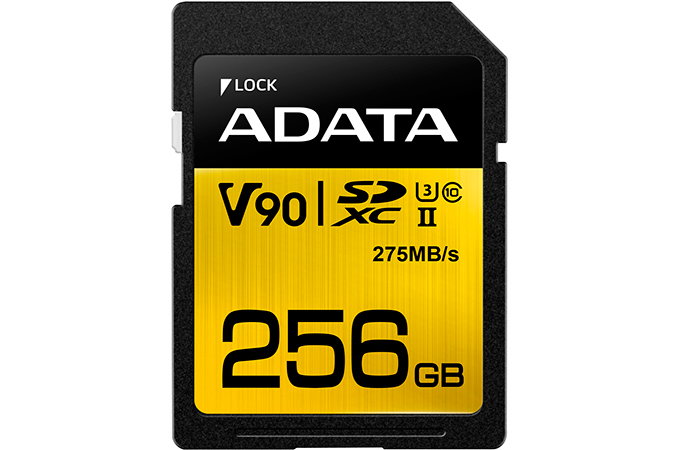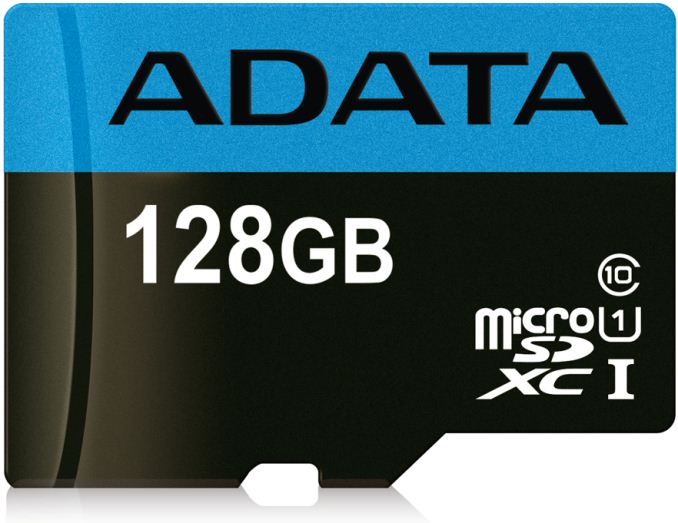ADATA Launches Premier ONE UHS-II SD Cards: 3D MLC, Up to 290 MB/s, V90 Labels
by Anton Shilov on April 17, 2017 12:00 PM EST- Posted in
- Memory Cards
- Storage
- ADATA
- SD cards
- Video Speed Class
- 3D MLC
- UHS-II

After previously demonstrating them back at CES, ADATA has officially launched its SD cards based on 3D MLC NAND. The new Premier ONE UHS-II cards offer capacities up to 256 GB, sequential read speed of up to 290 MB/s and extended temperature ranges. The new cards are also the first products from ADATA that are compliant with the V90 requirements for SD devices aimed at UHD and 360° video capture. In addition, ADATA has added Premier UHS-I Class 10 series of microSD cards with up to 128 GB capacity and mainstream performance levels to its product line.
The ADATA Premier ONE UHS-II cards will be available in 64 GB, 128 GB and 256 GB configurations in SDXC and microSDXC form-factors. The new memory cards are rated for up 275/290 MB/s sequential read speed as well as up to 155/260 MB/s sequential write speed, depending on the capacity and form-factor (the microSDXCs are a slower). The Premier ONE UHS-II cards are also compliant with Video Speed Class V90 specification, which mandates minimum write speed of 90 MB/s to smooth recording of UHD and 360° video. The enhanced performance of the new SD products by ADATA is enabled by 3D MLC NAND memory with large block and page sizes as well as a new controller (which I suspect uses some kind of pSLC technique to ensure fast writes, but that has not been confirmed by ADATA). In addition to performance-related improvements, the controller also supports write-in protection as well as ECC. To take full advantage of the new cards, one will need a device that fully supports the UHS-II interface and has the extra pins the wider bus requires. Still, the cards are compatible with all types of SD-supporting devices (cameras, card readers, etc.) albeit at lower speeds.
Another important selling point of the ADATA Premier ONE UHS-II cards is their rugged design. The SDs are explicitly adverised as being both waterproof and dust-proof. Meanwhile, the cards are also rated to work at extended temperature range between -25°C to 85°C, which makes them suitable for industrial applications.
| ADATA Premier ONE UHS-II and Premier UHS-I Class 10 SD Cards | ||||||||||||
| Premier ONE UHS-II | Premier UHS-I Class 10 | |||||||||||
| 64 GB | 128 GB | 256 GB | 64 GB | 128 GB | 256 GB | 16/32/64/128 GB | ||||||
| Form-Factor | SDXC | MicroSDXC | MicroSDHC/MicroSDXC | |||||||||
| NAND Type | 3D MLC | unknown | ||||||||||
| Read Speed | 290 MB/s | 275 MB/s | 85 MB/s | |||||||||
| Write Speed | 260 MB/s | 155MB/s | 25 MB/s | |||||||||
| Minimum Sequential Write Speed | 90 MB/s | 10 MB/s | ||||||||||
| Interface | UHS-II | UHS-I | ||||||||||
| Availability | Spring 2017 | |||||||||||
| SDA Labels | UHS-II, Class 10, U3, V90 | UHS-I, U1, Class 10 | ||||||||||
As for the Premier UHS-I Class 10 series of microSD cards, ADATA will offer them in 16 GB, 32 GB, 64 GB and 128 GB configurations, with up to 85 MB/s and up to 25 MB/s sequential read/write speeds. The cards also feature built-in ECC and are also protected against water and dust, but do not support extended temperature ranges.
ADATA has not announced recommended prices for its Premier ONE UHS-II SD and microSD cards. Since the devices offer a rather strong combination of features (high performance, V90-compliancy, extended temperature ranges, 3D MLC), they will naturally belong to the highest end of the SD spectrum. As for the Premier UHS-I Class 10 cards, expect them to be priced competitively against direct rivals.
Related Reading:
- Sony Announces SF-G UHS-II SD Cards: Up to Nearly 300 MB/s Read/Write Performance
- ADATA Demonstrates 256 GB microSDXC Card
- Patriot Introduces LX 256 GB microSDXC Card with Class 10, U3 Certifications
- Edge Memory Announces Video Speed Class SD Cards
- SD Association Announces UHS-III (up to 624 MB/s), A2 Class, LV Signaling
- The SD Card Association to Classify IOPS Performance of Memory Cards via Logo
- SD Association Announces SD 5.0 Specification: SD Cards For UHD and 360° Video Capture
Source: ADATA











16 Comments
View All Comments
damianrobertjones - Tuesday, April 18, 2017 - link
"(the microSDXCs are a slower)"It's a me, Mario!
Visual - Tuesday, April 18, 2017 - link
Speed improvements are nice and all, but is anyone actually limited by the current crop of cards with 90MB/s write to really care about this much?Prices on the other hand certainly can use some improvement. Even the slow 20MB/s write cards are disproportionately expensive per GB compared to SSDs, and the premium charged for faster cards makes it much worse. SD cards lack many features of SSDs, like TRIM, NCQ, block remapping, wear-leveling, DRAM caches and so on, so why are they so much more expensive?
haukionkannel - Tuesday, April 18, 2017 - link
Depends on. Playing music from phone... no problem. Taking 4K video with camera... you need more speed...taisingera - Tuesday, April 18, 2017 - link
Don't forget by Adata using 3d mlc nand inthese cards, there will be less available for SSDs and the price of SSD will increase even more.BrokenCrayons - Tuesday, April 18, 2017 - link
Meh, it's not a big problem since most SSDs sold these days are planar or 3D TLC. And stay tuned for QLC for even more savings passed directly to the consumer with only one more minor, but perfectly managable hit to endurance. </s>marius_zz - Monday, April 24, 2017 - link
it is time now to develop a new open source file system for all mobile devices because the exFAT is a fu**** g sh*** t